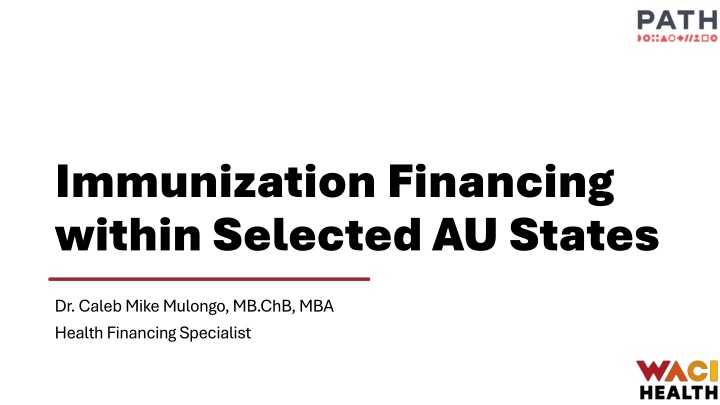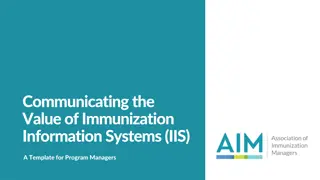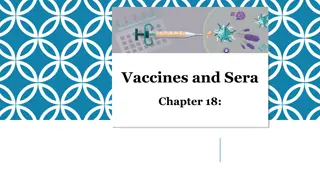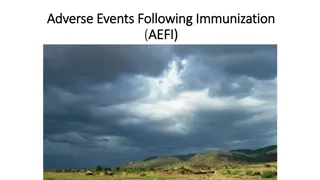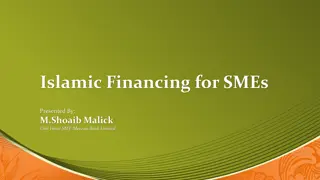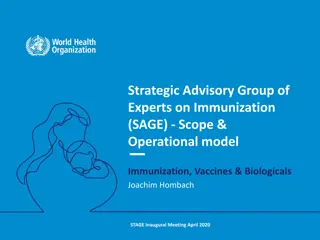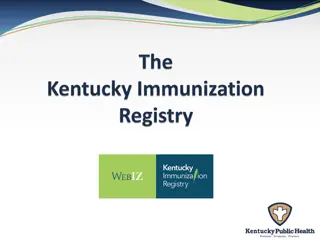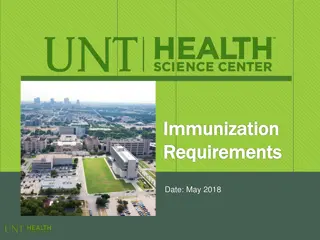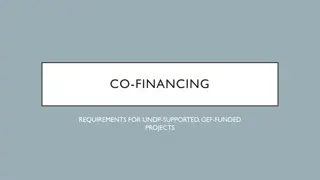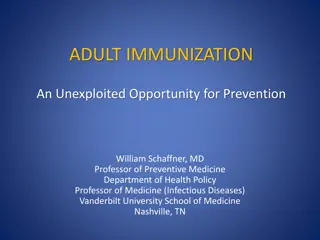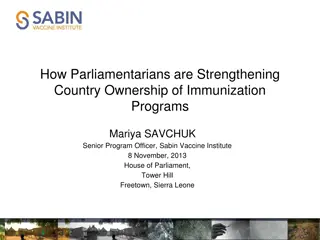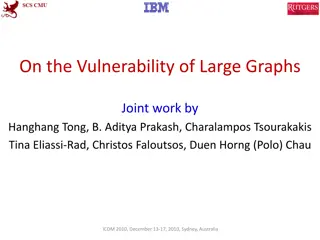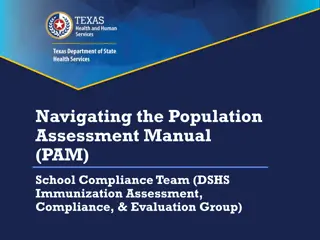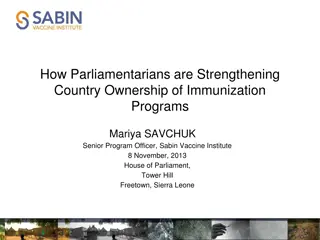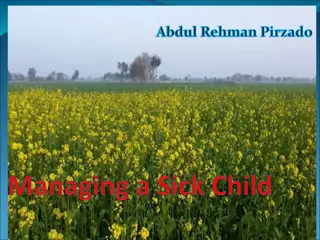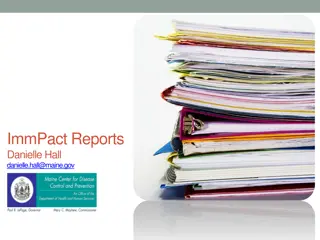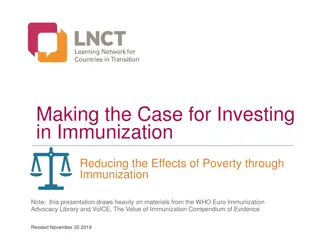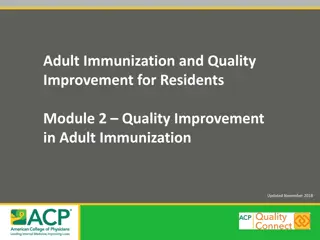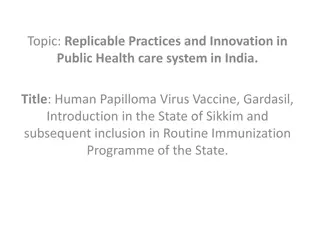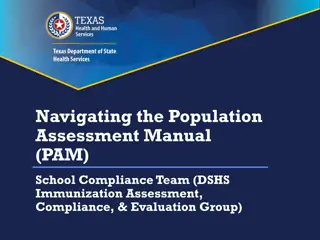Immunization Financing Analysis in Selected AU States
This analysis delves into the complex interplay of factors affecting immunization financing within selected African Union states. It explores economic contexts, health financing trends, donor dependence, coverage disparities, and more, shedding light on the challenges and opportunities in sustaining and enhancing immunization services in these regions.
Download Presentation

Please find below an Image/Link to download the presentation.
The content on the website is provided AS IS for your information and personal use only. It may not be sold, licensed, or shared on other websites without obtaining consent from the author.If you encounter any issues during the download, it is possible that the publisher has removed the file from their server.
You are allowed to download the files provided on this website for personal or commercial use, subject to the condition that they are used lawfully. All files are the property of their respective owners.
The content on the website is provided AS IS for your information and personal use only. It may not be sold, licensed, or shared on other websites without obtaining consent from the author.
E N D
Presentation Transcript
Immunization Financing within Selected AU States Dr. Caleb Mike Mulongo, MB.ChB, MBA Health Financing Specialist
Scope Analytic Framework BACKGROUND Premise Immunization Financing happens within a context with influences within and outside the health sector
GAVI Eligibility Guideline 2023 Eligibility within the Cluster Initial Self Financing (US$1085 GNI p.c.) Mozambique, DRC, Malawi, Uganda & Ethiopia; S. Sudan*. Preparatory Transition (>$1085 <$1730 GNI p.c.) Comoros, Senegal Accelerated Transition (US$ 1730 GNI p.c.) Kenya, Nigeria Fully Self Financing None Only 2 countries within the cluster are in the accelerated transition phase; Majority were in the Initial Self-Financing Phase Source: https://www.gavi.org/sites/default/files/programmes-impact/gavi-eligibility-and-transition-policy.pdf; https://www.gavi.org/sites/default/files/programmes-impact/Gavi-Co-financing-Policy.pdf
Economic Context High Public Debt and Low Tax Revenues limit the fiscal space for health & immunization. Economic performance Highlights Only Senegal and Mozambique > 15% Tax to GDP Ratio. Majority of countries have a Debt GDP ratio that exceeds the global and regional thresholds. (EAC 50%; Southern Africa 60%)
Health Financing Context Low budgetary prioritization threatens access, quality and sustainability of immunization services. Health Financing Trends Highlights Low Budgetary prioritization of immunization None met the health financing thresholds: a. 15% of Govt Budget- Abuja Target b. 5% of GDP Target c. USD86 per Capita Target
Health Financing Context High Donor Dependence and OOP Spending threatens sustainability and financial protection of immunization services. Health Financing Sources Highlights High Dependence on Donor Funding and Out of Pocket Financing for health. None of the countries contributes more than 40% of all health financing. Donor contributions accounted for more than 40% in Uganda, Malawi, South Sudan and Mozambique. Out of pocket payments (OOP) contributed more than 15%* in all the countries except for Mozambique. OOP were highest in Nigeria, Comoros and Senegal. *Recommended threshold for OOP is below 15%
Immunization Context Low Coverage of immunization services in conflict afflicted countries; and beyond 6months of age. Immunization Coverage Highlights Coverage was highest in Kenya, Comoros, Uganda, Malawi and Senegal. Coverage was lowest in conflict affected regions i.e., Nigeria, Ethiopia, DRC and South Sudan. Coverage was generally higher in vaccines given before 6 months- BCG, DTP 1 MCV 2 not consistent in all countries; newly introduced in most countries.
Immunization Financing Significant donor dependence in immunization financing within this cluster. Immunization Financing Sources Highlights Government funding accounted for about 25% of all immunization financing within this cluster hence high donor dependency. Senegal had the highest relative government contribution (44%) while DRC (9%), Comoros (12%) and South Sudan (12%) had the least government contribution to immunization financing While donors vary across the countries, GAVI, WHO, and UNICEF werethe most consistent and declared donor sources. Private sector contributions were not visible within the existing CMYPs*. Financing of Routine Immunization (2017-2022) 56% 63% 64% 66% 66% 75% 78% 86% 88% 88% 91% 44% 37% 36% 34% 34% 25% 22% 14% 12% 12% 9% Average Govt Contribution Average Partner Contribution *CMYPs: Country Multi-Year Plans
Immunization Financing Significant donor dependence in immunization financing within this cluster. Immunization Financing Trends Trend Analysis of Government Financing of Routine Immunization Highlights 100% 90% In 2022, Nigeria and Kenya had the highest government financing to Routine Immunization accounting for 55% and 50% respectively, while Comoros had the least government financing at 14% 80% 70% 60% 55% 50% 50% 36% 40% 29% 30% 30% 25% 20% 14% 10% 0% 2016 2017 2018 2019 2020 2021 2022 2023 DRC Comoros South Sudan Malawi Mozambique Uganda Kenya Ethiopia Nigeria Senegal
Immunization Financing Low Prioritization of immunization financing within this cluster. Immunization Financing Trends Components of Immunization Spending Highlights 41% 43% 44% 50% Procurement of vaccines alone consumed a large share of immunisation spending as it ranged between 41% and 50%. Efficiencies within the procurement and vaccine delivery systems can unlock more resources 59% 57% 56% 50% 2017 2018 2019 2020 Non-Vaccine Immunization Expenditures Vaccine Procurement Expenditures
LOOKING FORWARD: PRIORITIES PFM reforms to expand fiscal space for health & immunization Contextualize investments that promote domestic vaccine manufacturing Strengthen PHC Systems & Integration of Immunization Strengthen Collective Governance systems for accountability Invest in poverty reduction & alleviating drivers of inequality Pandemic & Disaster Preparedness
RECOMMENDATIONS: Short Term Capacity-building for immunization financing (forecasting, economic evaluation, budget cycles, expenditure tracking) Strengthen CSO capacity for Immunization advocacy, accountability, & synergy Advocacy for increased health and immunization budgets > cover routine & new vaccines Develop, Implement & Monitor costed national and subnational immunization plans Improve data management for evidence-based planning & financing Leverage technology for efficient vaccine delivery; immunization systems Advocacy for stronger political goodwill for immunization Foster strategic collaborations (local, regional, global).
RECOMMENDATIONS: Med- Long Term Advocacy Recommendations: Medium & Long Term Promote prepayment mechanisms e.g., tax- based health insurance schemes, subsidies for indigents PFM Reforms for effective debt management & enhanced tax administration Incentivize and promote domestic vaccine manufacturing Invest in poverty reduction & alleviating drivers of inequality Strengthen healthcare infrastructure & human resources > PHC & Integration of Immunization Strengthen Governance systemsfor accountability Address drivers of political instability Pandemic & Disaster Preparedness
